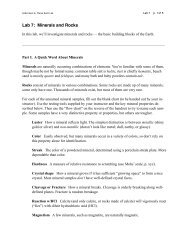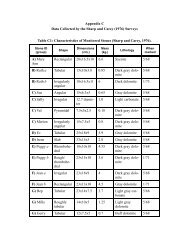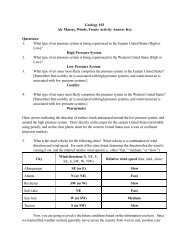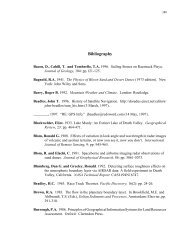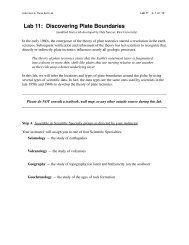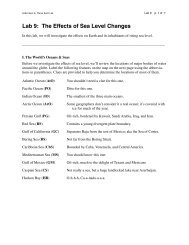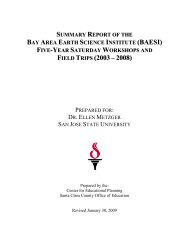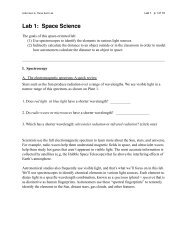You also want an ePaper? Increase the reach of your titles
YUMPU automatically turns print PDFs into web optimized ePapers that Google loves.
167<br />
<strong>Chapter</strong> 6<br />
<strong>Terrain</strong> <strong>Analysis</strong><br />
Given the emerging spatial patterns of the southern sliding rock field, further analyses<br />
were conducted in an attempt to link the Racetrack’s unusual surface phenomena to<br />
the surrounding terrain. By placing the playa within the context of its neighboring topography,<br />
the causative effects of wind channeling were hypothesized.<br />
6.1 DEM Data Transformations<br />
A three-by-three cluster of Digital Elevation Models (DEMs) of the Racetrack<br />
Playa and vicinity were purchased from the USGS. All DEMs are categorized as “Level<br />
1” data sets (see “3.12 DEM Data Accuracy” on page 76), indicating that they are of the<br />
highest accuracy possible under current data production methods.<br />
While it was initially assumed that all nine DEMs would be spliced together into<br />
one data set this ultimately proved superfluous. The entire boundary of the Racetrack<br />
Playa is luckily situated near the middle of the Ubehebe Peak 7.5-minute quadrangle, so<br />
seaming this data set to any of the other contiguous eight was not necessary. The lakebed<br />
is surrounded by mountains included in the Ubehebe Peak quad. Since the sliding rock<br />
phenomenon is spatially localized, adding more detail to the periphery served only to add<br />
unnecessarily to the volume of the data set. The terrain analyses that followed were com-
168<br />
putationally intensive, even for a single file. Practicality dictated limiting analysis to the<br />
central DEM.<br />
The data sets were delivered via CD-ROM. Each file, in its raw ASCII format,<br />
embodied about 1 Megabyte of data. Before the DEMs could be read by ArcView or Arc/<br />
Info, they had to have line delimiters added to result in a flat file of columns and rows.<br />
This was achieved using the UNIX dd command. The result was a file of 30-meter-square<br />
pixels, each assigned an elevation in meters.<br />
The files were imported to ArcView by converting the delimited files to Arc/Info<br />
“grid” format. As grids, ArcView was capable of reading each raster file when the Spatial<br />
Analyst extension was made active: this extension is an add-on program that allows for<br />
manipulation of elevation data. Figure 3.6 (page 79) shows some of the derived products<br />
composed using the Spatial Analyst. The Ubehebe Peak DEM was imported into a “view<br />
window” and displayed as a hill shaded relief map; then the vector (shape) files were<br />
added to the view. Since each file is georeferenced, the playa perimeter shape file should<br />
have lined up exactly with the terrain data; surprisingly, it did not. The shape files were<br />
offset about 200 meters slightly west of north from the position of the digital elevation<br />
model (see Figure 6.1). As stated in section 3.10 (page 74) USGS DEMs are referenced<br />
using either the North American Datum of 1927 (NAD 27) or the North American Datum<br />
of 1983 (NAD 83). The datum used for these DEMs was not specified, but the error<br />
appeared as if the datum used in the terrain models was different from that of the GPS<br />
data (which was collected using the World Geodetic System of 1984, or WGS84).<br />
At first, a rubber sheeting approach was attempted to bring the two data types to<br />
the same space, but this method brought with it significant systematic errors and was
169<br />
Figure 6.1: Incongruent overlays due to conflicting references. The hill shaded relief<br />
map of the Racetrack Playa (left) is based on the 7.5-minute Ubehebe Peak DEM,<br />
which is referenced to NAD27. Overlain on this is the GPS vector file of the Racetrack’s<br />
outline, based on WGS84. Note that the southern boundary of the playa is<br />
clearly offset from the topography. The inset outlines the Grandstand; the large scale<br />
detail (right) shows that the Grandstand (an easily recognizable feature) was about 200<br />
meters farther northwest in the WGS-referenced data.<br />
abandoned. Perusal of Arc/Info’s help screens clarified the problem, and suggested a<br />
solution. Using Arc/Info’s Project function, the Ubehebe Peak DEM was transformed to<br />
NAD83, thus shifting the pixels to coincide with the WGS84 vector files. Arc/Info did not<br />
have a straightforward transformation application to convert from NAD27 to WGS84, so<br />
NAD83 was used instead. NAD83 and WGS84 are virtually identical, both based on the<br />
1980 Geodetic Reference System (GRS80); the more recent DMA-developed WGS84<br />
spheroid carries calculations of the Earth’s shape to higher precision (Clarke, 1997).<br />
Changing the ellipsoid of the DEM files thus resulted in an accurate overlay of the GPSmapped<br />
data (Figure 6.2).
170<br />
A<br />
B<br />
Figure 6.2: Comparison of NAD83 to WGS84. The Ubehebe Peak DEM was referenced<br />
to NAD83 (upper left) from NAD27 (Figure 6.1). The Grandstand shape file<br />
(white outline, inset A) is aligned with its 30 x 30 meter raster representation. The<br />
south end of the playa (inset B) shows congruence with the dolomite cliffs.
171<br />
6.2 Derived Raster Data<br />
The Ubehebe Peak DEM was used to generate derivative slope and aspect data.<br />
Since a digital terrain model is organized as a table whose cells correspond to local elevations,<br />
pixel values may be computationally manipulated to yield applied data. A kernel<br />
mask considers a small group of pixels at a time, and progressively moves throughout the<br />
entire grid until every cell is assigned a value. This value may define the topographic gradient<br />
of each 30 x 30 meter element (as in the case of a slope map), or the compass direction<br />
of orientation for each 30 x 30 meter element (as in the case of an aspect map). These<br />
processes are described (after Burrough, 1986), and illustrated below (see Figure 6.3).<br />
Sample 3x3 array of 100 meter pixels<br />
Altitude<br />
Matrix:<br />
100 130 140<br />
Identifying<br />
Kernel:<br />
Z i-1,j+1<br />
Z i,j+1<br />
Z i+1,j+1<br />
120 150 160<br />
Z i-1,j<br />
Z i,j<br />
Z i+1,j<br />
160 170 200<br />
Z i-1,j-1<br />
Z i,j-1<br />
Z i+1,j-1<br />
Figure 6.3: A 300 meter square of nine elevation values. This example is used to<br />
derive slope and aspect of the central pixel below (Equations 6.1 and 6.2)<br />
To derive the slope of any one pixel, the following equation is used:<br />
TanG<br />
=<br />
( dZ)<br />
( ----------- 2 ( dZ )<br />
+<br />
dX)<br />
( ---------- 2<br />
dY)<br />
Equation 6.1<br />
where:<br />
[( dZ) ⁄ ( dX)<br />
]ij , =<br />
( Z ) 2Z i + 1,<br />
j + 1 i + 1 , j<br />
+ ( ) + ( Z ) Z i + 1 , j –<br />
– ( 1 i – 1 , j + 1<br />
) + ( 2Z ) +( Z )<br />
i– 1,<br />
j i – 1 , j – 1<br />
----------------------------------------------------------------------------------------------------------------------------------------------------------------------------------------<br />
8dX<br />
Z i – 1,<br />
j + 1<br />
[( dZ) ⁄ dY]ij<br />
,<br />
( ) + ( 2Z ) Z ij , +<br />
+ ( )– ( Z ) + ( 2Z ) +( Z )<br />
1 i + 1 , j + 1 i – 1 , j – 1 ij , – 1 i + 1 , j –<br />
= ------------------------------------------------------------------------------------------------------------------------------------------------------------------------------------------ 1<br />
8dY<br />
This is simply an expression of the Pythagorean Theorem. Substituting values to
172<br />
solve for the central pixel in Figure 6.3,<br />
( dZ)<br />
-----------<br />
( dX)<br />
[ 140m + ( 2)160m + 200m] – [ 100m + ( 2)120m + 160m]<br />
160m<br />
= ------------------------------------------------------------------------------------------------------------------------------------------- = ------------ = 0.2<br />
800m<br />
800m<br />
and:<br />
( dZ)<br />
----------<br />
( dY)<br />
[ 100m + ( 2)130m + 140m] – [ 160m + ( 2)170m + 200m]<br />
–200m<br />
= ------------------------------------------------------------------------------------------------------------------------------------------- = ---------------- = – 0.25<br />
800m<br />
800m<br />
Substituting in Equation 6.1:<br />
TanG = ( 0.2) 2 + (–<br />
0.25) 2 = 0.32<br />
so the slope of the central pixel in Figure 6.3 is derived by:<br />
ArcTan( 0.32) = 17.75 o<br />
To calculate the aspect of a pixel, the following equation is used:<br />
(–dZ) ⁄ ( dY)<br />
TanA = -----------------------------<br />
Equation 6.2<br />
( dZ) ⁄ ( dX)<br />
applied:<br />
This equation will yield a value for which the following decision rules must be<br />
• if dZ/dX is negative and dZ/dY is negative: add 90° to the value derived by Eq. 6.2<br />
• if dZ/dX is negative and dZ/dY is positive: subtract 90° from the value derived by Eq.<br />
6.2<br />
• if dZ/dX is positive and dZ/dY is negative: add 270° to the value derived by Eq. 6.2<br />
• if dZ/dX is positive and dZ/dY is positive: subtract 270° from the value derived by<br />
Eq. 6.2
173<br />
So for the central pixel in Figure 6.3, we substitute the following values:<br />
Aspect<br />
[–(–0.25)]<br />
= ArcTanA′ ------------------------- = 51.34 o<br />
0.2<br />
Since dZ/dX is positive, dZ/dY is negative, 270° is added to the outcome shown<br />
above to yield a final value of 321.32°. A cursory examination of the subset shown in Figure<br />
6.4 suggests that the central pixel must be sloping towards the northwest since the elevation<br />
is lowest (100 meters) in the northwest corner and highest in the southeast (200<br />
meters). When slope and aspect maps are developed by a GIS, these calculations are carried<br />
out for every pixel in the grid, usually in a matter of seconds. Therefore, for a 1-<br />
degree DEM more than 1.44 million separate calculations are conducted for the 1,201 x<br />
1,201 array. The advantages of automated processes are apparent.<br />
A slope map assigns hypsometric tints to inclination classes, thus indicating where<br />
on a landscape the terrain is rugged, and where it is flat. Aspect maps code regions by the<br />
direction in which each pixel or pixel cluster faces. These calculations are necessary precursors<br />
to produce hill shaded relief images, in which reflectivity is inferred by these<br />
derived data when combined with an operator-input azimuth and inclination for the sun.<br />
Figure 6.4 shows a slope map of the Ubehebe Peak DEM, and Figure 6.5 shows an aspect<br />
map of the same data set.
174<br />
Ubehebe Peak 7.5-minute DEM<br />
Slope Map<br />
2500 0 2500 5000 Meters<br />
Slope of Ubehebe<br />
Peak DEM<br />
(degrees)<br />
0-4.9<br />
5-9.9<br />
10-14.9<br />
15-19.9<br />
20-24.9<br />
25-29.9<br />
30-34.9<br />
35-39.9<br />
40-44.9<br />
45-49.9<br />
50-54.9<br />
55-59.9<br />
60-64.9<br />
Figure 6.4: Slope Map of Ubehebe Peak quadrangle. Note the Basin and Range<br />
topography of generally north-south trending flat areas (controlled by structural<br />
faults). Gently-sloping alluvial fans encroach the playa on the north, east and south.<br />
This map was constructed with the USGS Ubehebe Peak DEM and ArcView’s Spatial<br />
Analyst extension. The outline of the Racetrack Playa is the GPS vector data that was<br />
collected in July 1996. UTM projection, zone 11.
175<br />
Ubehebe Peak 7.5-minute DEM<br />
Aspect Map<br />
Aspect of Ube hebe<br />
Peak DEM<br />
(degrees)<br />
Flat<br />
(-1 )<br />
North<br />
(0-22.5,337.5-360)<br />
Northeast<br />
(22.5-67.5)<br />
East<br />
(67.5-112.5)<br />
Southeast<br />
(112.5-157.5)<br />
South<br />
(157.5-202.5)<br />
Southwest<br />
(202.5-247.5)<br />
West<br />
(247.5-292.5)<br />
3000 0 3000 6000 Meters<br />
Northwes t<br />
(292.5-337.5)<br />
No Da ta<br />
Figure 6.5: Aspect map of the Ubehebe Peak quadrangle. When used in conjunction<br />
with Figure 6.5, this map can give the viewer insight into the fault-blocked mountains<br />
surrounding flat basins. Although the alluvial fans slope gently onto the playa floor,<br />
their slope headings are nonetheless captured by this map.<br />
The map was constructed with the USGS Ubehebe Peak DEM and ArcView’s<br />
Spatial Analyst extension. The outline of the Racetrack Playa is the GPS vector data<br />
that was collected in July 1996. Note the disparity in boundary between the playa<br />
polygon and raster data. This is most likely due to the diffuse nature of the northern<br />
and eastern borders. UTM projection, zone 11.
176<br />
6.3 Correlating the Sliding Rock Trails to the Surrounding <strong>Terrain</strong><br />
Among the clearest patterns to emerge from the numerical data described in <strong>Chapter</strong><br />
5 is the favored trail heading in Octant 0, accounting for over 53% of all cumulative<br />
motion. While other correlations were elusive at best, this general tendency for rocks to<br />
slide to the north-northeast deserved further consideration. It had been established by<br />
Sharp and Carey (1976) that prevailing winds in the area are from the south-southwest,<br />
which is consistent with the preferential direction of movement observed in this survey.<br />
Yet the existence of such a strong directional propensity may be influenced by the local<br />
terrain and microtopography surrounding the lake bed. Figure 6.6 shows a contour map of<br />
Figure 6.6: Contour map of south end of Ubehebe Peak DEM. Notice the<br />
topographic corridors (indicated by gray arrows) to the south of the Racetrack.<br />
Contours constructed as vector features with a 50-meter interval using<br />
ArcView 3.0’s Spatial Analyst.
177<br />
the south end of the playa, highlighting saddles through which air may be channeled and<br />
directed onto the playa. Figure 6.7 shows a perspective view of the southwest saddle<br />
where two corridors converge, serving to concentrate airflow directly onto the sliding rock<br />
field.<br />
There is a high degree of parallelism between the major heading component of<br />
most trails and these natural airways. To statistically test the surrounding topography’s<br />
influence on rock motion, the aspect (compass direction of slope orientation) of the local<br />
terrain was examined.<br />
6.3.1 Neighborhood Aspect <strong>Analysis</strong><br />
The sliding rock field is concentrated at the south end of the Racetrack, so the<br />
Figure 6.7: Perspective view of the southwest sector of the Racetrack Basin. The two<br />
arrows in the extreme southwest corner of Figure 6.7 are shown here as would be seen<br />
from the southern playa shoreline. If air is channeled through these saddles, currents<br />
converge onto the flat Racetrack floor.<br />
This image is based on the one-degree USGS Death Valley-West DEM, processed<br />
as a grid using Arc/Info and imported into ERDAS Imagine version 8.2.
...<br />
178<br />
influence of winds may be somewhat limited in scope. Since all rock trails were digitized,<br />
each start point was known (see Table G4 in Appendix G); each start point represents a<br />
place where air forces exceeded a rock’s coefficient of static friction thereby propelling<br />
the rock. The zone on the playa that encompassed all start points is a bounding “neighborhood”<br />
polygon of every such point in the data set, and is the area on which further studies<br />
are based (see Figure 6.8).<br />
To test whether the aspect of the terrain elements within a limited distance from<br />
this “neighborhood” polygon had influence over rock motion, a second polygon was constructed<br />
with a border 2000 meters from that of the bounding polygon. The extent of this<br />
demarcation is illustrated in Figure 6.9. The 2000 meter buffer was used to filter any ter-<br />
.<br />
. .<br />
.<br />
.<br />
..<br />
... .<br />
.. .. ..<br />
....<br />
.. . ....<br />
. ..<br />
..<br />
.. .<br />
..... ..<br />
.... .<br />
. .. . ... ..<br />
..<br />
..<br />
.<br />
.<br />
.<br />
Figure 6.8: Bounding polygon of sliding rock start points. The dark gray shape file is<br />
superimposed on a hill shaded relief image of Racetrack Basin. White dots indicate<br />
trail origin points.
179<br />
2000 m.<br />
Key:<br />
Fla t (-1 )<br />
North (0-22.5,337.5-360)<br />
Northeast (22.5-67.5)<br />
East (67.5-112.5)<br />
Sou thea s t (1 12 .5-15 7.5 )<br />
South (157.5-202.5)<br />
Southwest (202.5-247.5)<br />
We s t (2 47 .5 -29 2.5)<br />
No rthwe s t (2 92 .5-33 7.5 )<br />
0 1000 2000 Me te rs<br />
Figure 6.9: Buffer zone surrounding the bounding polygon. The hillshaded relief<br />
image (top) shows the extent of the elevation data included in visibility analyses (see<br />
section 6.32). The aspect map (bottom) shows the same buffer zone; this time the pixels<br />
are coded for azimuth of inclination.<br />
rain data beyond that distance from the rock field. Once the DEM was filtered, an aspect<br />
data set was created from this subset. The resultant “clipped” aspect map was the base<br />
map for the next phase of analysis.
180<br />
visible<br />
invisible<br />
invisible<br />
visible<br />
viewpoint<br />
Figure 6.11: Intervisibility using ray tracing. (After Clarke, 1995)<br />
6.3.2 Viewshed Analyses<br />
The rocks at Racetrack Playa lie on a flat plane, but are surrounded by intricate<br />
landforms. Air is forced through natural channels, but each rock may be subject to slight<br />
differences in wind velocity based on its location relative to the fringing topography.<br />
Given a digital cartographic representation of a terrain surface and a single point<br />
on the surface, the set of regions that are visible from that point describe intervisibility<br />
(Clarke, 1995). Intervisibility is determined by a method known as ray tracing, and is<br />
illustrated in Figure 6.11. The viewshed, or 360 o panorama of the visible terrain around<br />
each rock is a function of its placement and height above the surface. On a perfectly flat<br />
terrain, a viewshed would extend to the visible horizon in all directions. Any substantial<br />
relief such as a mountain acts as a barrier to the panorama, and also as a shield to air currents<br />
at shorter ranges. Processing viewsheds for representative rocks could establish the<br />
existence of significant variations in the terrain in the neighboring buffer zone, and hence<br />
associated airflow potentials.
181<br />
For this study, the start points of twelve rocks were selected. The subset of rocks<br />
was chosen based on several criteria: spatial distribution on the playa; representation of a<br />
range of trail straightness ratios; representation of a range of trail lengths; representation<br />
of a range of rock sizes. Selection rationalization for each rock is listed in Table 6.1.<br />
.<br />
Table 6.1: Twelve-rock Visibility Subset Selection Criteria<br />
Rock<br />
Number/Name<br />
UTM Coordinates of<br />
Start Point<br />
Easting<br />
(X)<br />
Northing<br />
(Y)<br />
Rationale<br />
031 Jacki 450131.0 4057974.5 Although starting nearly 37 meters apart<br />
032 Amelia 450099.9 4057956.3<br />
on the playa, these trails end in highly parallel<br />
“scribbles.”<br />
045 Karen 450025.4 4058639.4 One of the three largest rocks; situated at<br />
the northwestern neighborhood limit.<br />
050 Alice 450235.0 4058450.5 The second most crooked trail (0.271<br />
straightness quotient).<br />
063 Marietta 450215.9 4057719.6 The most southerly start point.<br />
069 Sandra 450013.9 4057625.9 An extreme southwesterly start point.<br />
073 Claudia 450125.1 4058042.0 The most crooked trail (0.187 straightness<br />
quotient).<br />
080 Sheryl 450199.6 4057998.8 The straightest trails of appreciable<br />
084 Jospehine 450237.5 4057784.0<br />
length * (0.997 straightness quotient).<br />
140 Debbie 450726.8 4058005.2 An extreme southeasterly start point.<br />
141 April 450953.3 4058866.9 The most northeasterly start point.<br />
145 Diane 450444.5 4057957.6 The longest trail (881 meters).<br />
*139 Agnes is the straightest trail, but it measures only 6 meters in length. As a result, 080 Sheryl<br />
and 084 Josephine (with trail lengths of 26 and 84 meters, respectively) were included instead.<br />
Each of the twelve trail origin points were saved as point coverages using Arc/Info
182<br />
generate. Point files were cleaned and projected to UTM. The Ubehebe Peak DEM was<br />
cropped using the Arc command latticeclip: the polygon coverage of the 2000-meter<br />
buffer zone acted as a “cookie cutter.” The resulting DEM extended 2000 meters beyond<br />
the limit of the bounding polygon in all directions, and was named .<br />
Using each of the twelve point coverages individually, the Arc command visibility<br />
computed the 360 o viewshed for each start point. The usage for this command, using<br />
Amelia as an example is:<br />
where:<br />
visibility point grid<br />
• is the 2000-meter buffer cropped DEM-derived aspect map,<br />
• is the point coverage of Amelia’s origin,<br />
• “point” specifies that the viewshed will be based on one point (as opposed to a line),<br />
• is the name of the viewshed grid file generated,<br />
• “grid” specifies that the output file is a raster grid.<br />
It should be noted that this process is computationally intensive and quite time-consuming.<br />
When the grids were output to ArcView their associated data base files were<br />
exported to Excel. The original clipped DEM encompassing the 2000-meter buffer zone<br />
contained 22,749 30x30-meter pixels. Since this value was known, as were the total number<br />
of visible pixels in each rock’s viewshed, the “visibility ratio” of each rock was computed.<br />
The quotient of the rock’s visible pixels to the total number of pixels in the<br />
buffered grid describes the relative intervisibility for that rock before it started moving.<br />
Table 6.2 shows the relative viewsheds for the twelve representative rocks.
183<br />
Table 6.2: Number of Pixels Visible/Invisible to Twelve Representative Rocks<br />
Rock Name/<br />
Number<br />
Number of<br />
Pixels<br />
Visible<br />
Number of<br />
Pixels<br />
Invisible<br />
Visibility<br />
Quotient<br />
Alice 050 15205 7544 .6684<br />
Amelia 032 14595 8154 .6416<br />
April 141 13354 9395 .5870<br />
Claudia 073 14727 8022 .6474<br />
Debbie 140 16406 6343 .7212<br />
Diane 145 13515 9234 .5941<br />
Jacki 031 14517 8232 .6381<br />
Josephine 084 13036 9713 .5730<br />
Karen 045 15834 6915 .6960<br />
Marietta 063 11972 10777 .5263<br />
Sandra 069 12452 10297 .5474<br />
Sheryl 080 14339 8410 .6303<br />
As is evident in Figure 6.11, the rocks selected for the visibility studies describe an<br />
approximately normal distribution of visibility profiles. A cursory analysis of Table 6.2<br />
shows that the longest trail (Diane) had one of the smallest number of visible viewshed<br />
pixels at its start point. Given this possible link to total intervisibility area and trail character,<br />
several regression analyses were implemented. The results of those scatter plots are<br />
presented in Table 6.3.
184<br />
4<br />
4<br />
3<br />
3<br />
Frequency<br />
2<br />
1<br />
2<br />
2<br />
1<br />
0<br />
0.50-0.55 0.55-0.60 0.60-0.65 0.65-0.70 0.70-0.75<br />
Visibility Quotient<br />
Figure 6.11: Frequency distribution of visibility quotients for representative rocks.<br />
Table 6.3: Results of Selected Visibility-Related Regression Analyses<br />
X variable<br />
Y variable<br />
Relationship<br />
(+ = direct;<br />
- = inverse)<br />
Correlation<br />
Coefficient<br />
(r 2 )<br />
Number of<br />
Total Visible<br />
Pixels in<br />
Viewshed<br />
Straightness Quotient of Trail - 0.1679<br />
Distance to Springs of Trail Start Point - 0.0842<br />
Direct Trail Length - 0.0135<br />
Total Trail Length + 0.0061<br />
Relationships between trail character parameters and number of viewshed pixels<br />
were weak. However, the analyses above weighted all visible pixels equally. Since the<br />
goal of this study was to associate qualities of trails with the surrounding terrain, further<br />
intervisibility area details were needed. An aspect analysis of the DEM subset <br />
was generated, and named . The twelve raster files resulting from the visibility
185<br />
analysis function (see “visibility . . .” on page 182) were converted to polygons<br />
using Arc’s gridpoly function. All twelve coverages were named ,<br />
projected to UTM, and then cleaned. These coverages were in turn used as “cookie cutters”<br />
on the cropped aspect map, “clipasp.” The command for Amelia, for example was:<br />
where:<br />
latticeclip <br />
• is the grid of aspect-coded pixels to be cropped,<br />
• is the viewshed polygon,<br />
• is the output viewshed grid<br />
The resulting twelve rocks’ “-vis” grids were raster files of the aspect of every visible<br />
pixel in that rock’s viewshed, before it started moving to its current location.<br />
The tabular data from these manipulations were exported to Microsoft Excel. The<br />
spreadheets, as exported by ArcView, consisted of two columns, one for the compass<br />
heading and the other for the total number of pixels in the viewshed with that orientation<br />
for each rock. There were up to 361 rows for each rock, one row for the flat pixels in the<br />
viewshed (labeled “-1 o ”), and one row and associated number of pixels for each compass<br />
heading (1 o to 360 o ).<br />
Once the spreadsheet was constructed, pixels were “clumped” into eight groups to<br />
match the octant categories already defined. Table 6.4 shows the summation limits.
186<br />
Table 6.4: Aspect Designation by Octant<br />
Octants<br />
0 1 2 3 4 5 6 7<br />
Inclusive Headings 1-45 46-<br />
90<br />
91-<br />
135<br />
136-<br />
180<br />
181-<br />
225<br />
226-<br />
270<br />
271-<br />
315<br />
316-<br />
360<br />
The data were summed further to produce groups of the four cardinal compass<br />
directions, and again to those offset by 45 o . Table 6.5 shows these distributions.<br />
Table 6.5: Aspect Designation by Quadrant<br />
Quadrants<br />
N E S W NE SE SW NW<br />
Inclusive Headings 1-45;<br />
316-360<br />
96-<br />
135<br />
136-<br />
225<br />
226-<br />
315<br />
1-<br />
90<br />
91-<br />
180<br />
181-<br />
270<br />
271-<br />
360<br />
A summary of the total number of visible pixels by Octant (Table 6.5) follows.
187<br />
Table 6.5: Number of Visible Pixels in Viewshed of Rock, by Octant<br />
Rock<br />
Name/<br />
Number<br />
Octants<br />
0 1 2 3 4 5 6 7<br />
Total Inclined<br />
Pixels<br />
Flat Pixels<br />
Total Pixels in<br />
Viewshed<br />
Alice<br />
050<br />
Amelia<br />
032<br />
April<br />
141<br />
Claudia<br />
73<br />
Debbie<br />
140<br />
Diane<br />
145<br />
Jacki<br />
31<br />
Josephine<br />
84<br />
Karen<br />
45<br />
Marietta<br />
63<br />
Sandra<br />
69<br />
Sheryl<br />
80<br />
857 2086 1612 324 515 1562 1575 1269 9800 5405 15205<br />
717 2054 1602 333 495 1633 1402 954 9190 5405 14595<br />
746 2155 1616 300 381 932 1137 884 8151 5203 13354<br />
740 2059 1604 332 496 1623 1422 1041 9317 5410 14727<br />
898 2089 1489 354 621 1939 2142 1443 10975 5431 16406<br />
620 2083 1602 317 431 1273 1176 710 8212 5303 13515<br />
720 2056 1600 331 488 1618 1367 935 9115 5402 14517<br />
510 2036 1589 325 458 1372 955 445 7690 5346 13036<br />
873 2090 1526 321 566 1750 1898 1387 10411 5423 15834<br />
363 1988 1540 318 436 1207 720 177 6749 5223 11972<br />
492 1919 1532 322 464 1375 714 378 7196 5256 12452<br />
714 2055 1601 331 482 1525 1316 922 8946 5393 14339
188<br />
as follows:<br />
The pixel counts for octants were added together defining viewsheds by quadrant,<br />
• Σ pixels in Octants 7 + 0 describe visible North-facing slopes,<br />
• Σ pixels in Octants 1 + 2 describe visible East-facing slopes,<br />
• Σ pixels in Octants 3 + 4 describe visible South-facing slopes,<br />
• Σ pixels in Octants 5 + 6 describe visible West-facing slopes,<br />
• Σ pixels in Octants 0 + 1 describe visible Northeast-facing slopes,<br />
• Σ pixels in Octants 2 + 3 describe visible Southeast-facing slopes,<br />
• Σ pixels in Octants 4 + 5 describe visible Southwest-facing slopes,<br />
• Σ pixels in Octants 6 + 7 describe visible Northwest-facing slopes.<br />
These totals may be found in Tables H1 and H2 in Appendix H.<br />
6.3.3 Trail Heading Correlations to Surrounding Visible Topography<br />
Motion of the rocks is inferred by the pattern of their trails: Table G5 in Appendix<br />
G lists motion by octants; Table G6 in Appendix G lists the percentages of a rock’s route<br />
in each octant. As noted by Figures 5.27 (page 153) and 5.28 (page 154) the greatest<br />
directional component for the majority of trails was in Octant 0 (north-northeast). When a<br />
similar analysis is conducted on the representative samples’ visible pixel aspects, it is evident<br />
that the heading of surrounding terrain elements are not random and are related to the<br />
design of the trails. Table H3 in Appendix H shows the percentage of visible pixels per<br />
octant and per quadrant of each of the rocks, excluding the flat terrain. Figure 6.12 shows<br />
the viewshed means for all rocks.<br />
For the twelve representative rocks, percentages of direction components per trail<br />
and orientation of pixel elements per viewshed were calculated, by quadrant. Table H4 in<br />
Appendix H shows the complete data for individual trails and viewsheds. These data were<br />
then averaged by quadrant (Table 6.6). A comparison of the sampled rocks’ mean trail<br />
segment headings to their visible pixel aspects shows some interesting patterns.
189<br />
25%<br />
23.73%<br />
20%<br />
18.24%<br />
16.85%<br />
Percent of Visible Pixels<br />
15%<br />
10%<br />
5%<br />
7.71%<br />
3.76%<br />
5.55%<br />
14.61%<br />
9.56%<br />
0%<br />
0 1 2 3 4 5 6 7<br />
Octant<br />
Figure 6.12: Mean percentage of aspects visible to representative rocks, by octant.<br />
.<br />
Table 6.6: Pixel Aspect Means for Sampled Rocks’ Viewsheds and Corresponding<br />
Trail Heading Means, by Quadrant<br />
North East South West<br />
Aspect of<br />
Viewshed<br />
Pixels<br />
Trail Heading<br />
Components<br />
17.26% 41.97% 9.31% 31.46%<br />
66.36% 6.38% 10.92% 16.34%<br />
Northeast Southeast Southwest Northwest<br />
Aspect of<br />
Viewshed<br />
Pixels<br />
Trail Heading<br />
Components<br />
31.44% 22.00% 22.40% 24.17%<br />
44.41% 13.41% 2.97% 39.22%
190<br />
There is a noticeable inverse relationship between aspect of viewsheds and trail<br />
headings. Particularly in the cardinal directions (top) Table 6.6 shows that high values in a<br />
particular quadrant for pixel aspects corresponded to low values for trail headings, and<br />
vice versa. The relationship in the offset quadrants (bottom) are more diffuse.<br />
When percentages for complementing quadrants are summed and compared, the<br />
results suggest a significant relationship between trail character and terrain. Figure 6.13<br />
shows the correspondence.<br />
100%<br />
90%<br />
80%<br />
70%<br />
60%<br />
50%<br />
40%<br />
30%<br />
20%<br />
10%<br />
0%<br />
93.17%<br />
73.43%<br />
26.57%<br />
6.83%<br />
53.84%<br />
52.03%<br />
46.16%<br />
47.97%<br />
N-S E-W NE-SW NW-SE<br />
Sector<br />
Trails<br />
Aspects<br />
Figure 6.13: Comparison of pixel aspects to trail component headings for averages of<br />
twelve representative rocks.<br />
The trails show a directional preference to the quadrants orthogonal to the majority<br />
of the pixel aspects’ orientations. In other words, a preponderance of east- or westfacing<br />
slopes appears to be correlated with the general north-south plans of the trails. This<br />
is particularly evident of north-south, east-west correlations in Figure 6.13.
191<br />
To check the interdependence of trails to their surrounding orthogonal terrain elements<br />
t-Tests were conducted. Tests on whether the paired data support a null hypothesis<br />
(i.e., there is no relationship between the trails’ directions and orientation of the surrounding<br />
slopes) allowed the null hypothesis to be rejected at the 95% confidence level<br />
(α=0.05). The results of two such comparisons are shown in Table 6.7.<br />
Table 6.7: Results of t-Tests for <strong>Terrain</strong>-Trail Paired Data<br />
NE-SW<br />
Trails<br />
NW-SE<br />
<strong>Terrain</strong><br />
N-S Trails<br />
E-W <strong>Terrain</strong><br />
Mean 51.76 46.16 78.95 73.43<br />
Variance 1344.38 8.99 819.88 11.96<br />
Observations 12 12 12 12<br />
Pearson Correlation<br />
Hypothesized<br />
Mean Difference<br />
0.117 -0.550<br />
0 0<br />
df 11 11<br />
t Stat 0.532 0.624<br />
P(T





